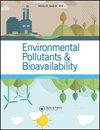从污染地区分离的原生细菌将亚硒酸盐转化为元素硒
Q3 Chemical Engineering
引用次数: 24
摘要
摘要本研究主要是利用枯草芽孢杆菌、逸出杆菌、地衣芽孢杆菌和假碱性假单胞菌等菌株,将高可溶性、高毒性的亚硒酸盐转化为低毒性的单质硒。通过改变pH、温度、不同硒浓度(200、400和600 μg ml−1)、曝气和孵育时间等物理参数来优化亚硒酸盐还原的条件。硒还原率随pH的增加而增加,pH 9时亚硒酸盐还原率平均为28-90%,pH 3时亚硒酸盐还原率平均为15-33%。所有菌株分别在32℃、37℃和42℃三种温度下培养,以确定最佳温度。在不同温度下观察到亚硒酸盐的还原,结果表明每个菌株对硒的最佳还原有不同的偏好。测定了不同亚硒酸盐初始浓度对硒的还原作用,结果表明,在较低的初始浓度(200 μg ml−1)下,硒的最大还原量降低。本研究表明,亚硒酸盐还原菌在好氧和厌氧环境下均能修复硒,其还原能力随培养时间的增加而降低。本文章由计算机程序翻译,如有差异,请以英文原文为准。
Conversion of selenite to elemental selenium by indigenous bacteria isolated from polluted areas
Abstract The present research work is on the biotic transformation of highly soluble and toxic selenite to less toxic elemental selenium using bacterial strains Bacillus subtilis, Exiguobacterium sp., Bacillus licheniformis, and Pseudomonas pseudoalcaligenes. The conditions were optimized by changing different physical parameters such as pH, temperature, different Selenium (Se) concentration levels (200, 400, and 600 μg ml−1), aeration, and incubation time for increased selenite reduction. The Se reduction rate increased with increase in pH. On average, 28–90% selenite reduction was observed at pH 9, while 15–33% at pH 3. To check the optimum temperature, all strains were cultured at three temperatures 32, 37, and 42 °C. Selenite reduction was observed at various temperatures and the results show that each strain has different preferences for optimum Se reduction. Selenite reduction was also monitored using different initial selenite concentrations and the results showed that at lower initial concentration (200 μg ml−1) maximum Se was reduced. This study showed that selenite-reducing bacteria can remediate Se in both aerobic and anaerobic environments, as well as their reduction ability decreases with increase in incubation time.
求助全文
通过发布文献求助,成功后即可免费获取论文全文。
去求助
来源期刊
CiteScore
1.62
自引率
0.00%
发文量
0
审稿时长
1 months
期刊介绍:
Chemical Speciation & Bioavailability ( CS&B) is a scholarly, peer-reviewed forum for insights on the chemical aspects of occurrence, distribution, transport, transformation, transfer, fate, and effects of substances in the environment and biota, and their impacts on the uptake of the substances by living organisms. Substances of interests include both beneficial and toxic ones, especially nutrients, heavy metals, persistent organic pollutants, and emerging contaminants, such as engineered nanomaterials, as well as pharmaceuticals and personal-care products as pollutants. It is the aim of this Journal to develop an international community of experienced colleagues to promote the research, discussion, review, and spread of information on chemical speciation and bioavailability, which is a topic of interest to researchers in many disciplines, including environmental, chemical, biological, food, medical, toxicology, and health sciences.
Key themes in the scope of the Journal include, but are not limited to, the following “6Ms”:
Methods for speciation analysis and the evaluation of bioavailability, especially the development, validation, and application of novel methods and techniques.
Media that sustain the processes of release, distribution, transformation, and transfer of chemical speciation; of particular interest are emerging contaminants, such as engineered nanomaterials, pharmaceuticals, and personal-care products.
Mobility of substance species in environment and biota, either spatially or temporally.
Matters that influence the chemical speciation and bioavailability, mainly environmentally relevant conditions.
Mechanisms that govern the transport, transformation, transfer, and fate of chemical speciation in the environment, and the biouptake of substances.
Models for the simulation of chemical speciation and bioavailability, and for the prediction of toxicity.
Chemical Speciation & Bioavailability is a fully open access journal. This means all submitted articles will, if accepted, be available for anyone to read, anywhere, at any time. immediately on publication. There are no charges for submission to this journal.

 求助内容:
求助内容: 应助结果提醒方式:
应助结果提醒方式:


